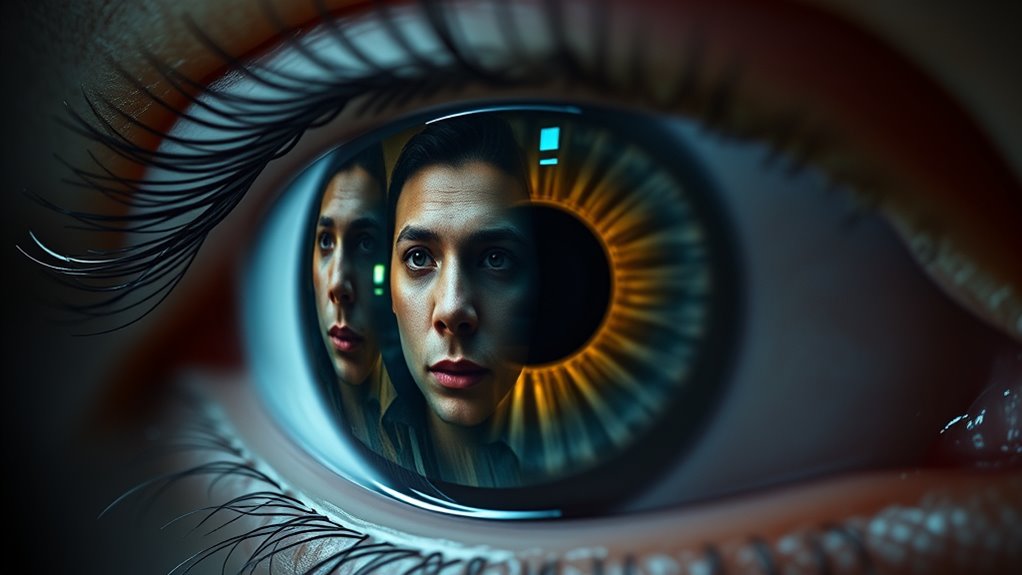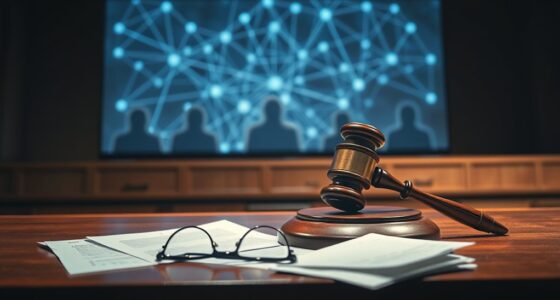AI-powered deepfakes are transforming the media landscape, making it easier to create highly realistic fake videos and audio that can spread misinformation or manipulate opinions. While these tools open new opportunities for entertainment and education, they also pose serious risks to trust and authenticity. Malicious actors can exploit this technology to damage reputations or sway public perception. To stay informed and protect yourself, explore how these innovations challenge truth and what strategies can help you identify and navigate false content.
Key Takeaways
- Deepfakes, realistic synthetic media created by AI, can spread misinformation and manipulate public perception.
- Advances in AI make detecting deepfakes increasingly challenging, raising concerns about digital trust.
- Recognizing signs like unnatural facial movements and audio inconsistencies helps identify manipulated content.
- Ethical standards and media literacy are essential to mitigate the risks of misinformation via deepfakes.
- Supporting technological solutions and transparency promotes responsible AI use and preserves content authenticity.

Artificial intelligence has revolutionized the way we create and manipulate visual and audio content, giving rise to deepfakes—highly realistic synthetic media that can convincingly imitate real people. While these advancements open exciting possibilities for entertainment and innovation, they also pose significant challenges to digital ethics and content authenticity. As someone steering through this new landscape, you must understand that deepfakes can blur the line between truth and fiction, making it harder to trust what you see and hear online. The ease with which AI can produce convincing false media demands a heightened awareness of digital ethics—principles that guide responsible creation and sharing of content. You need to critically evaluate sources, question the authenticity of images or videos, and stay informed about the latest tools designed to detect manipulated media. Recognizing the growing importance of media literacy is essential in navigating this complex environment effectively. Deepfakes threaten content authenticity because they can be used maliciously to spread misinformation, sway public opinion, or damage reputations. Imagine encountering a video of a political leader making controversial statements or a celebrity endorsing a product you distrust—without knowing whether they are genuine. These synthetic media can be tailored to manipulate emotions and influence decisions, which makes it essential for you to develop media literacy skills. Recognizing signs of deepfake content involves looking for inconsistencies, such as unnatural facial movements or irregularities in audio synchronization, but AI technology is rapidly improving, making detection more difficult. This creates a complex challenge: balancing the innovative uses of deepfakes—like in film production or educational content—with the risk of misuse. As you engage with digital media, it’s important to advocate for transparency and accountability in the AI community. Support initiatives that promote ethical standards and technologies capable of verifying content authenticity. Understanding that digital ethics isn’t just a responsibility for creators but also for consumers helps foster a more trustworthy digital environment. Ultimately, staying vigilant about deepfakes means cultivating a skeptical mindset and relying on trusted sources. The proliferation of highly convincing synthetic media underscores the importance of ongoing education and technological solutions to combat misinformation. By doing so, you contribute to a digital space where creativity and truth coexist, and where ethical standards guide the responsible use of AI. Navigating this landscape requires constant vigilance, but with the right mindset, you can help uphold the integrity of digital content in an era dominated by advanced AI-generated media.
Frequently Asked Questions
How Can Individuals Identify Deepfakes Effectively?
To identify deepfakes effectively, you should enhance your digital literacy and practice visual verification. Look for inconsistencies like unnatural blinking, mismatched shadows, or irregular facial movements. Use reverse image searches or video analysis tools to verify authenticity. Always question suspicious content, cross-check with trusted sources, and stay informed about common deepfake techniques. Developing these skills helps you spot fake videos quickly and avoid spreading misinformation.
What Legal Measures Exist Against Malicious Deepfake Creators?
You should be aware that legal frameworks and content regulation are evolving to combat malicious deepfake creators. For instance, in 2020, a court sentenced a creator for non-consensual deepfake videos, illustrating legal action taken against such offenses. These laws aim to hold offenders accountable, penalize harmful content, and protect individuals’ rights. As deepfake technology advances, expect more thorough legal measures to deter malicious use and guarantee responsible content creation.
How Do Deepfakes Impact Political Stability Worldwide?
Deepfakes threaten political stability worldwide by fueling media manipulation and eroding trust in institutions. You might see false videos that sway public opinion or discredit leaders, making it harder to discern truth. This manipulation can lead to social unrest or undermine democratic processes. As a result, deepfakes destabilize politics by creating confusion and skepticism, forcing societies to constantly verify information and defend against malicious misinformation campaigns.
Can Ai-Generated Deepfakes Be Used Positively?
Yes, AI-generated deepfakes can be used positively. You can explore ethical applications, such as enhancing education through realistic historical recreations or supporting therapy by creating empathetic virtual environments. Additionally, deepfakes enable creative uses in film, advertising, and art, allowing you to produce innovative content that engages audiences in new ways. When used responsibly, deepfakes can inspire, educate, and entertain without spreading misinformation.
What Are the Future Technological Advancements in Detecting Deepfakes?
Future advancements in deepfake detection will focus on AI authentication, making it easier for you to verify authentic content. You can expect more sophisticated algorithms that analyze subtle inconsistencies and biometric patterns, improving accuracy. These innovations will empower you to identify deepfakes quickly, reducing misinformation’s impact. As technology evolves, you’ll benefit from smarter, faster tools that help keep your online environment trustworthy and secure.
Conclusion
As you navigate this digital landscape, remember that over 96% of deepfakes are used for malicious purposes, highlighting the urgent need for vigilance. AI and deepfakes are powerful tools that can easily distort reality, making it essential for you to stay informed and skeptical of suspicious content. The more aware you are of these technologies’ potential, the better you can protect yourself from misinformation and help shape a more truthful online environment.









